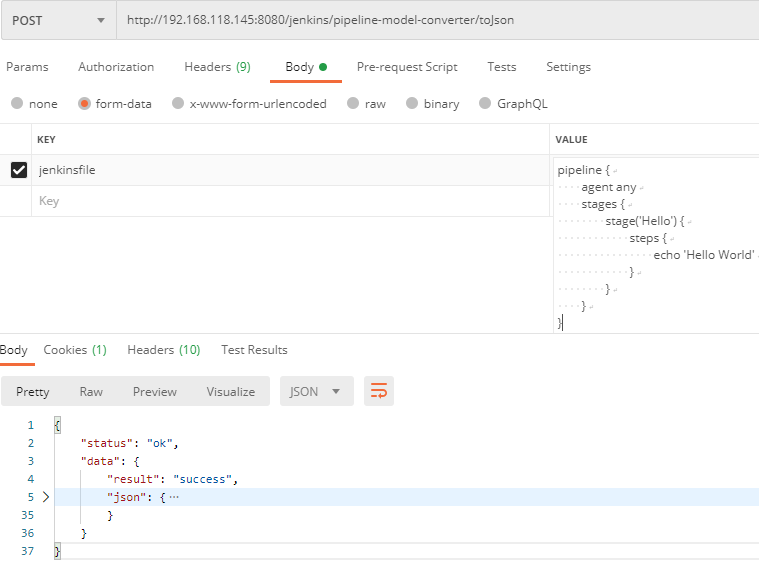jenkins:實現Jenkinsfile與Json的轉換
阿新 • • 發佈:2021-02-09
### 實現Jenkinsfile與Json的轉換
[TOC]
最近在做個需求,需要支援Jenkinsfile和json的轉換。
### 方法1:使用現有的jenkins外掛
參考的是[這篇文章](https://www.cnblogs.com/w1570631036/p/11726599.html)。下面介紹一下將外掛打包成映象的步驟:
- 本地安裝jdk和maven,jdk建議採用的版本為8(該工程會依賴一個名為`tools.jar`的包,jdk 9之後移除了該包)
如果本地沒有找到`tools.jar`,可以下載一個1.8版本的jdk,然後在`pom.xml`中增加如下依賴
```xml
```
- clone [pipeline-model-definition-plugin](https://github.com/jenkinsci/pipeline-model-definition-plugin)工程
- 在/root/.m2/目錄下建立`settings.xml`,內容來自[Jenkins官方](https://wiki.jenkins.io/display/JENKINS/Plugin+tutorial):
```xml
```
- 執行 `mvn install`進行編譯
- 由於主要用到的是Jenkinsfile和json之間的轉換關係,因此主要用的是如下兩個REST API:
- **Conversion to JSON representation from Jenkinsfile**
- *URL*: `JENKINS_URL/pipeline-model-converter/toJson`
- *Parameters*: `jenkinsfile` - the `Jenkinsfile` contents
- *Info*: Takes a `Jenkinsfile` and converts it to the JSON representation for its `pipeline` step.
- *Returns*: JSON with a `result` field that will either be `success` or `failure`. If `success`, the JSON representation will be in the `json` field. If `failure`, there'll be an additional array in the `errors` field of the error messages encountered.
- **Conversion to Jenkinsfile from JSON representation**
- *URL*: `JENKINS_URL/pipeline-model-converter/toJenkinsfile`
- *Parameters*: `json` - the JSON representation of the model
- *Info*: Takes the JSON representation of the model and converts it to the contents for a `Jenkinsfile` invoking the `pipeline` step.
- *Returns*: JSON with a `result` field that will either be `success` or `failure`. If `success`, the `Jenkinsfile` contents will be in the `jenkinsfile` field. If `failure`, there'll be an additional array in the `errors` field of the error messages encountered.
上述兩個API在`pipeline-model-definition-plugin/pipeline-model-definition`目錄下,因此在該目錄下直接執行:`mvn hpi:run -Dhost=0.0.0.0 -Djetty.port=8080`即可。
- 將json轉換為Jenkinsfile的操作如下:
 完整的返回值如下:
```json
{
"status": "ok",
"data": {
"result": "success",
"json": {
"pipeline": {
"stages": [
{
"name": "Hello",
"branches": [
{
"name": "default",
"steps": [
{
"name": "echo",
"arguments": [
{
"key": "message",
"value": {
"isLiteral": true,
"value": "Hello World"
}
}
]
}
]
}
]
}
],
"agent": {
"type": "any"
}
}
}
}
}
```
- 將Jenkinsfile轉換為json的操作如下
完整的返回值如下:
```json
{
"status": "ok",
"data": {
"result": "success",
"json": {
"pipeline": {
"stages": [
{
"name": "Hello",
"branches": [
{
"name": "default",
"steps": [
{
"name": "echo",
"arguments": [
{
"key": "message",
"value": {
"isLiteral": true,
"value": "Hello World"
}
}
]
}
]
}
]
}
],
"agent": {
"type": "any"
}
}
}
}
}
```
- 將Jenkinsfile轉換為json的操作如下

 完整的返回值如下:
```json
{
"status": "ok",
"data": {
"result": "success",
"json": {
"pipeline": {
"stages": [
{
"name": "Hello",
"branches": [
{
"name": "default",
"steps": [
{
"name": "echo",
"arguments": [
{
"key": "message",
"value": {
"isLiteral": true,
"value": "Hello World"
}
}
]
}
]
}
]
}
],
"agent": {
"type": "any"
}
}
}
}
}
```
- 將Jenkinsfile轉換為json的操作如下
完整的返回值如下:
```json
{
"status": "ok",
"data": {
"result": "success",
"json": {
"pipeline": {
"stages": [
{
"name": "Hello",
"branches": [
{
"name": "default",
"steps": [
{
"name": "echo",
"arguments": [
{
"key": "message",
"value": {
"isLiteral": true,
"value": "Hello World"
}
}
]
}
]
}
]
}
],
"agent": {
"type": "any"
}
}
}
}
}
```
- 將Jenkinsfile轉換為json的操作如下

